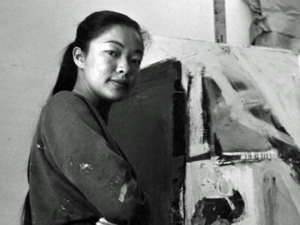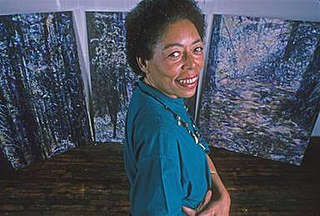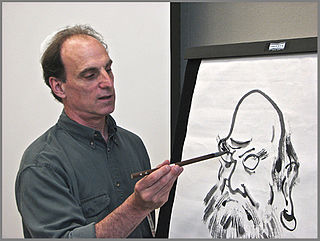Related Research Articles

In European academic traditions, fine art is made primarily for aesthetics or creative expression, distinguishing it from decorative art or applied art, which also has to serve some practical function, such as pottery or most metalwork. In the aesthetic theories developed in the Italian Renaissance, the highest art was that which allowed the full expression and display of the artist's imagination, unrestricted by any of the practical considerations involved in, say, making and decorating a teapot. It was also considered important that making the artwork did not involve dividing the work between different individuals with specialized skills, as might be necessary with a piece of furniture, for example. Even within the fine arts, there was a hierarchy of genres based on the amount of creative imagination required, with history painting placed higher than still life.
Gordon Onslow Ford was one of the last surviving members of the 1930s Paris surrealist group surrounding André Breton.

Robert L. Williams, often styled Robt. Williams, is an American painter, cartoonist, and founder of Juxtapoz Art & Culture Magazine. Williams was one of the group of artists who produced Zap Comix, along with other underground cartoonists, such as Robert Crumb, S. Clay Wilson, and Gilbert Shelton. His mix of California car culture, cinematic apocalypticism, and film noir helped to create a new genre of psychedelic imagery.

Arthur Thrall was an American painter and printmaker. His works have been shown in more than 500 exhibits in the United States and abroad including England, Finland, Germany, and U.S. embassies. Milwaukee Journal-Sentinel art critic James Auer said Thrall is one to "defy the dictates of fashion" and "whose high-styled uses of calligraphy rival those of the great age of the Ottomans." His work explores the abstract qualities of the alphabet and recalls "the elegant hand scripts in ceremonial documents and proclamations of an earlier age," re-creating "the tensions and rhythms emerging from a historic document."

Hans Gustav Burkhardt was a Swiss-American abstract expressionist artist.

Linda Vallejo is an American artist known for painting, sculpture and ceramics. Her work often addresses her Mexican-American ethnic identity within the context of American art and popular culture. The founder of the commercial art gallery Galería Las Américas, she is also an arts educator and has been involved intraditional Native American and Mexican rituals and ceremonies for many years.

Buddhism played an important role in the development of Japanese art between the 6th and the 16th centuries. Buddhist art and Buddhist religious thought came to Japan from China through Korea. Buddhist art was encouraged by Crown Prince Shōtoku in the Suiko period in the sixth century, and by Emperor Shōmu in the Nara period in the eighth century. In the early Heian period, Buddhist art and architecture greatly influenced the traditional Shinto arts, and Buddhist painting became fashionable among wealthy Japanese. The Kamakura period saw a flowering of Japanese Buddhist sculpture, whose origins are in the works of Heian period sculptor Jōchō. During this period, outstanding busshi appeared one after another in the Kei school, and Unkei, Kaikei, and Tankei were especially famous. The Amida sect of Buddhism provided the basis for many popular artworks. Buddhist art became popular among the masses via scroll paintings, paintings used in worship and paintings of Buddhas, saint's lives, hells and other religious themes. Under the Zen sect of Buddhism, portraiture of priests such as Bodhidharma became popular as well as scroll calligraphy and sumi-e brush painting.
Bingyi, is a Chinese artist, curator, scholar, architectural designer, cultural critic and activist.
Pouran Jinchi is an Iranian-American, New York-based artist. She is best known for her abstract, calligraphy-based contemporary visual art.

Bernice Bing was a Chinese American lesbian artist involved in the San Francisco Bay Area art scene in the 1960s. She was known for her interest in the Beats and Zen Buddhism, and for the "calligraphy-inspired abstraction" in her paintings, which she adopted after studying with Saburo Hasegawa.
Shizu Saldamando, is an American visual artist. Her work merges painting and collage in portraits that often deal with social constructs of identity and subcultures. Saldamando also works in video, installation and performance art. She has been featured in numerous exhibitions, has attained accolades like that of Wanlass Artist in Residence, and is a successful writer, tattoo artist, and social activist.

Vivian E. Browne was an American artist. Born in Laurel, Florida, Browne was mostly known for her painting series called Little Men and her Africa series. She is also known for linking abstraction to nature in her tree paintings and in a series of abstract works made with layers of silk that were influenced by her travels to China. She was an activist, professor, and has received multiple awards for her work. According to her mother, Browne died at age 64 from bladder cancer.

Michael Hofmann is an artist and teacher. He has been an active sumi-e painter since moving from the United States to Japan in 1972. For 33 years Hofmann worked closely with Jikihara Gyokusei (1904-2005), the prominent sumi-e painter, Abbot of Kokusei-ji Temple, Awajishima and Director of Japan's National Association of Nanga Painters. Hofmann has taught sumi-e ink painting at universities, museums and cultural institutions in both Japan and the United States. He has illustrated numerous books and his work has been exhibited extensively in galleries and museums.
Dyani White Hawk is a contemporary artist and curator of Sicangu Lakota, German, and Welsh ancestry based out of Minnesota. From 2010 to 2015, White Hawk was a curator for the Minneapolis gallery All My Relations. As an artist, White Hawk's work aesthetic is characterized by a combination of modern abstract painting and traditional Lakota art. White Hawk's pieces reflect both her Western, American upbringing and her indigenous ancestors mediums and modes for creating visual art.
Sonia Amalia Romero is an American artist, she is known for her printmaking, mixed media linocut prints, murals, and public art based in Los Angeles. She is known for depicting Los Angeles, Latin American imagery, and Chicano themes in her work.

Ynez Johnston was an American painter, sculptor, printmaker, and educator. Known for her work in painting, printmaking, and mixed media, Johnston was particularly inspired by Byzantine art, as well as Tibetan, Indian, Mexican, and Nepalese art from her extensive travels. Johnston was based in the San Francisco Bay Area in early life, and moved to Los Angeles in 1949.

Saburō Hasegawa was a Japanese-born American calligrapher, painter, art writer, curator, and teacher. He was an early advocate of abstract art in Japan and an equally vocal supporter of the Japanese traditional arts and Zen Buddhism. Throughout his career he argued for the connection between East Asian classical arts and Western abstract painting.

Anna Chek Ying Wong was a Canadian artist, master printmaker and educator. She taught for 20 years at the Pratt Graphics Center.
Yolanda González is a Chicana multimedia artist based in Los Angeles. She primarily works in ceramics, drawing, painting, and printmaking.
Nancy Genn is an American artist living and working in Berkeley, California known for works in a variety of media, including paintings, bronze sculpture, printmaking, and handmade paper rooted in the Japanese washi paper making tradition. Her work explores geometric abstraction, non-objective form, and calligraphic mark making, and features light, landscape, water, and architecture motifs. She is influenced by her extensive travels, and Asian craft, aesthetics and spiritual traditions.
References
- ↑ Donelan, Charles (2017-05-01). "Joanne Julian: "Defying Darkness: Selected Works 2009-2016" at the Carnegie Art Museum". art ltd. magazine. Retrieved 2019-03-10.
- ↑ Geer, Suvan (May 2017). "Visual Art Source". www.visualartsource.com. Retrieved 2019-03-10.
- ↑ McArthur, Meher (September 2015). "Zen Buddhist Aesthetics in the Works of Joanne Julian | Buddhistdoor". www.buddhistdoor.net. Retrieved 2019-03-10.
- 1 2 "biography". Joanne Julian Studio. Retrieved 2022-12-02.
- ↑ McArthur, Meher (2015-08-30). "Flawless Fluidity in the Works of Joanne Julian". KCET . Archived from the original on 2022-12-02. Retrieved 2022-12-02.
- ↑ "Joanne Julian Studio". www.joannejulian.com. Retrieved 2023-12-08.